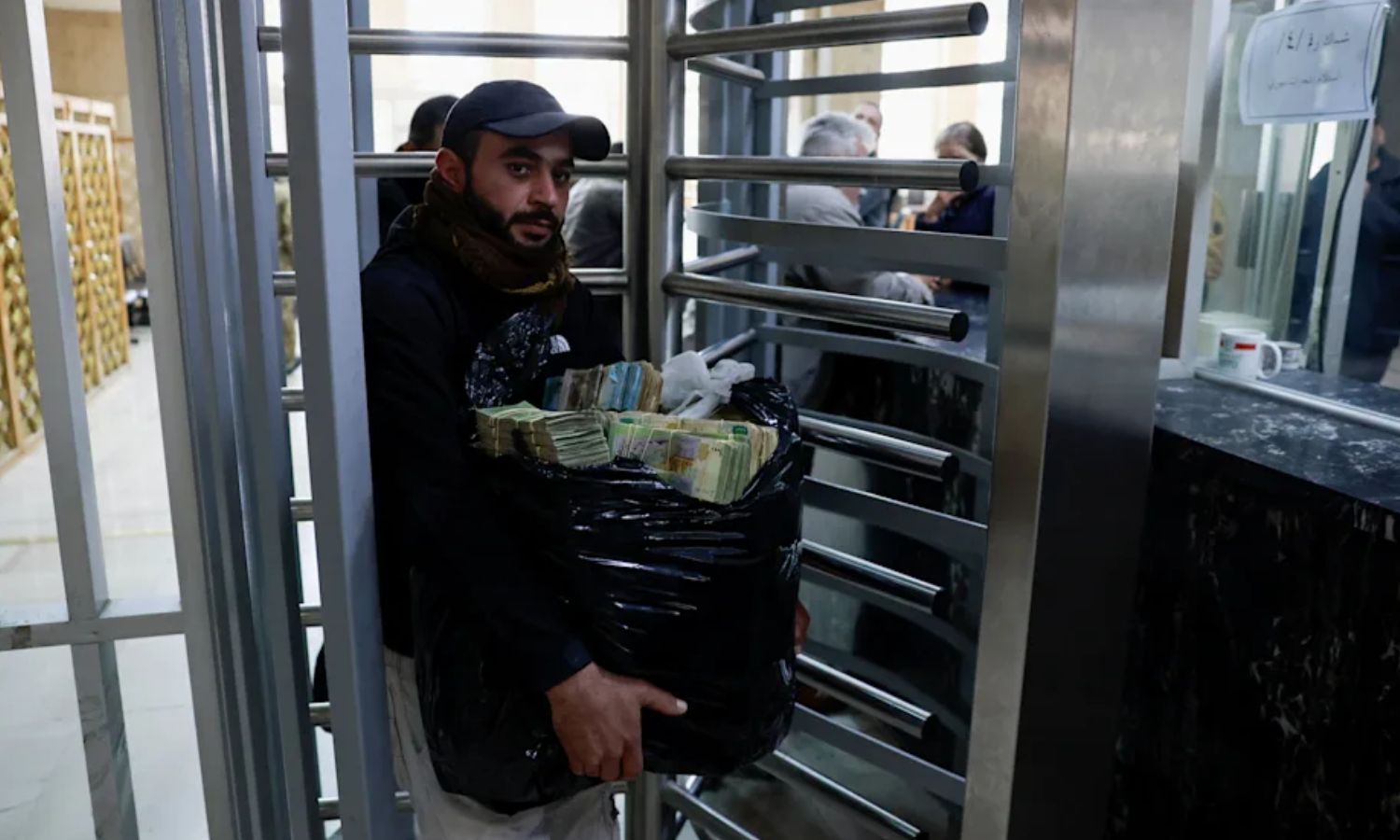The Syrian Central Bank’s recent liquidity lockdown has sparked widespread discontent, severely impacting citizens’ purchasing power and further exacerbating economic instability.
Many Syrians interviewed by Enab Baladi reported being unable to withdraw funds from their bank accounts due to a critical shortage of liquidity. Private banks, citing restrictions, have refused to allow citizens access to their salaries or deposits, intensifying financial distress.
This policy has significantly disrupted the flow of money, stifling economic activity and hindering investment.
Strict Withdrawal Limits and Economic Consequences
Several private banks have imposed a daily withdrawal cap of 250,000 Syrian pounds—an amount insufficient to cover even basic household expenses. Effectively, this means that liquidity is concentrated within the Central Bank and financial institutions, leaving individuals with no choice but to deplete their savings.
As a result, many Syrians have resorted to exchanging their foreign currency savings—primarily U.S. dollars—or relying on remittances from abroad, even at unfavorable exchange rates dictated by the Central Bank.
However, the fluctuating exchange rate has forced licensed money exchange offices to shut down in recent days. Meanwhile, unlicensed street exchangers, particularly in Damascus’ Saba Bahrat Square—located near the Central Bank—continue to operate without oversight.
Merchants, struggling to maintain their businesses amid the liquidity crisis, have turned to heavy discounts and promotional offers to generate cash flow, allowing them to cover rent and payroll expenses.
A Crisis of Production and Consumption
Economist Firas Shaabo explained to Enab Baladi that restricting liquidity halts production, describing the situation as a case of “demand suppression.” When liquidity is drained from the market, consumer spending becomes limited to essentials, causing a sharp decline in sales. This, in turn, renders merchants and industrialists unable to cover production costs.
An even more alarming consequence is the depreciation of the U.S. dollar against the Syrian pound, triggered by the enforced retention of liquidity. This artificial suppression increases production costs, further straining businesses.
On an individual level, savings have lost significant value. Just two months ago, $10,000 was worth approximately 150 million Syrian pounds. Today, that same amount is valued at just 100 million pounds or less—without a corresponding drop in prices, further eroding purchasing power.
Call for Economic Reforms
Shaabo stressed the urgent need for a gradual reintroduction of liquidity into the market, along with easing withdrawal restrictions to restore economic stability. With minimal government spending contributing to the liquidity crunch, he argued that state institutions must resume normal financial operations and allow depositors to access their funds.
He also pointed to the substantial amount—approximately 1.5 trillion Syrian pounds—trapped in the government’s import financing platform. Returning these funds to their rightful owners, Shaabo noted, would help alleviate financial strain, but such measures must be carefully phased to prevent further volatility in the exchange rate.
Lack of Transparency in Monetary Policy
The closure of exchange companies has added another layer of uncertainty. The Central Bank recently imposed stringent licensing requirements, mandating a $20 million deposit for money transfer companies and $1 million for money exchange offices. Many firms have resisted these conditions, leading to ongoing negotiations.
Shaabo warned that these closures create opportunities for influential figures to manipulate the exchange rate for their own benefit.
Meanwhile, the Central Bank issued a directive on February 5, permitting banks to sell U.S. dollars credited to customers’ accounts in exchange for Syrian pounds at the official exchange rate. While this measure could provide some economic relief, Shaabo emphasized that more decisive action is needed to restore confidence in the financial system.
Liquidity Lockdown: A Political and Administrative Strategy?
According to Shaabo, part of the liquidity lockdown was a deliberate priority for the new government. However, another key factor was administrative control: with the banking system nearly depleted of funds, authorities sought to restrict transactions involving accounts linked to former regime figures, particularly those tied to security and financial networks.
Cash liquidity remains a fundamental pillar of economic stability, yet most Syrians now struggle to access even small amounts for daily transactions. There is also no clear data on the total volume of Syrian currency in circulation—a critical issue for policymakers and economists alike.
To regain financial control, Shaabo argued, the Central Bank must establish stronger regulatory mechanisms, ensuring that banks comply with official exchange rates. At present, the bank’s role is largely limited to issuing exchange rate bulletins without effective enforcement.
Sanctions and Economic Struggles
Shaabo concluded that international sanctions on Syria have significantly constrained the banking sector, limiting financial operations and deepening the economic crisis. While the Syrian pound has shown nominal improvement, real purchasing power continues to decline due to persistently high prices and stagnant wages.
The erosion of purchasing power is directly linked to inflation and exchange rate instability. As inflation rises, the value of money diminishes, reducing the number of goods and services a single unit of currency can buy. Conversely, a stronger currency boosts purchasing power—but this has yet to materialize in Syria’s struggling economy.
Following the collapse of the former regime, the Central Bank sought to reassure citizens by declaring that all deposits and funds within Syrian banks remained secure. However, in practice, widespread withdrawal restrictions and liquidity shortages suggest a far more uncertain financial future for ordinary Syrians.
This article was translated and edited by The Syrian Observer. The Syrian Observer has not verified the content of this story. Responsibility for the information and views set out in this article lies entirely with the author.


